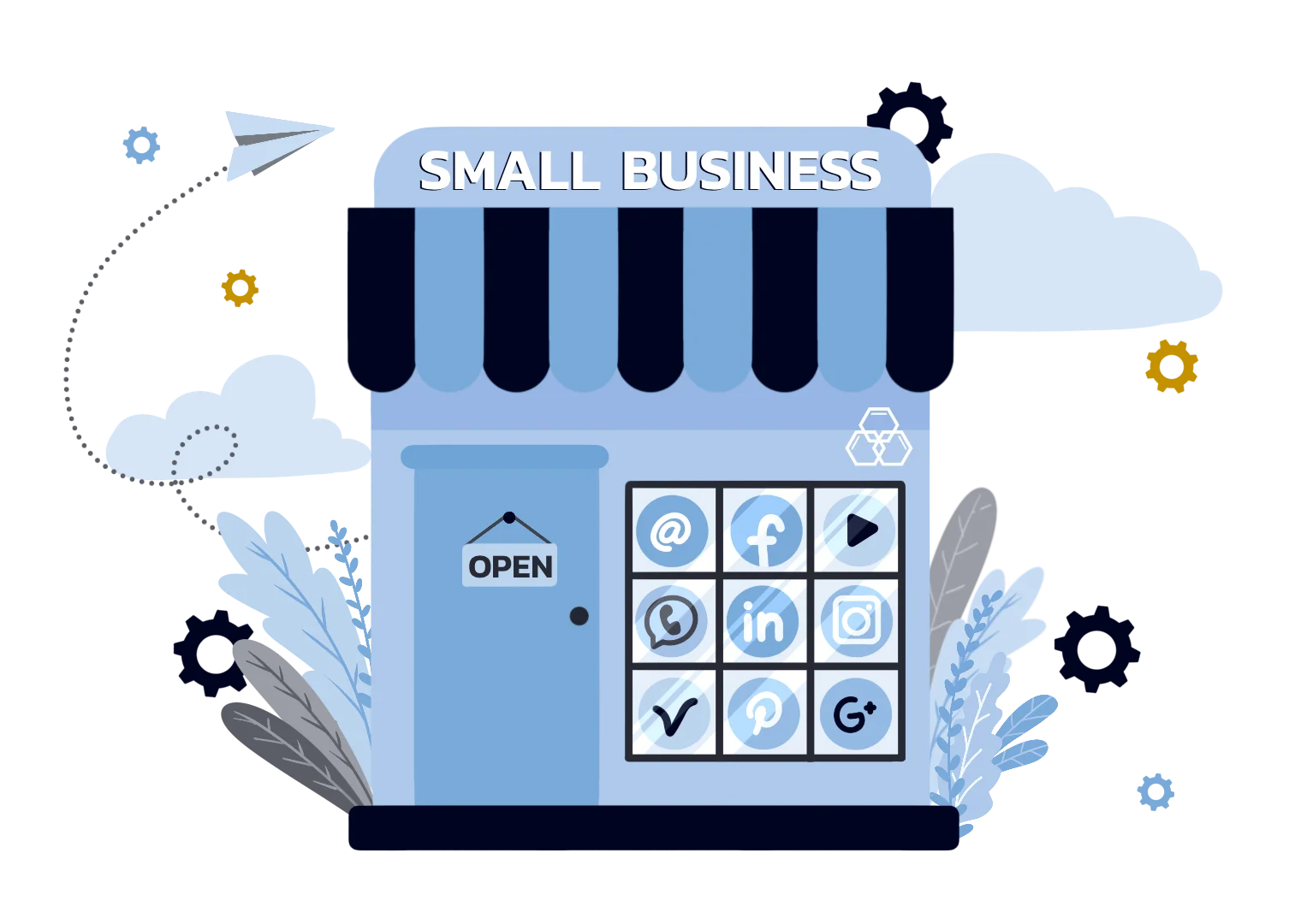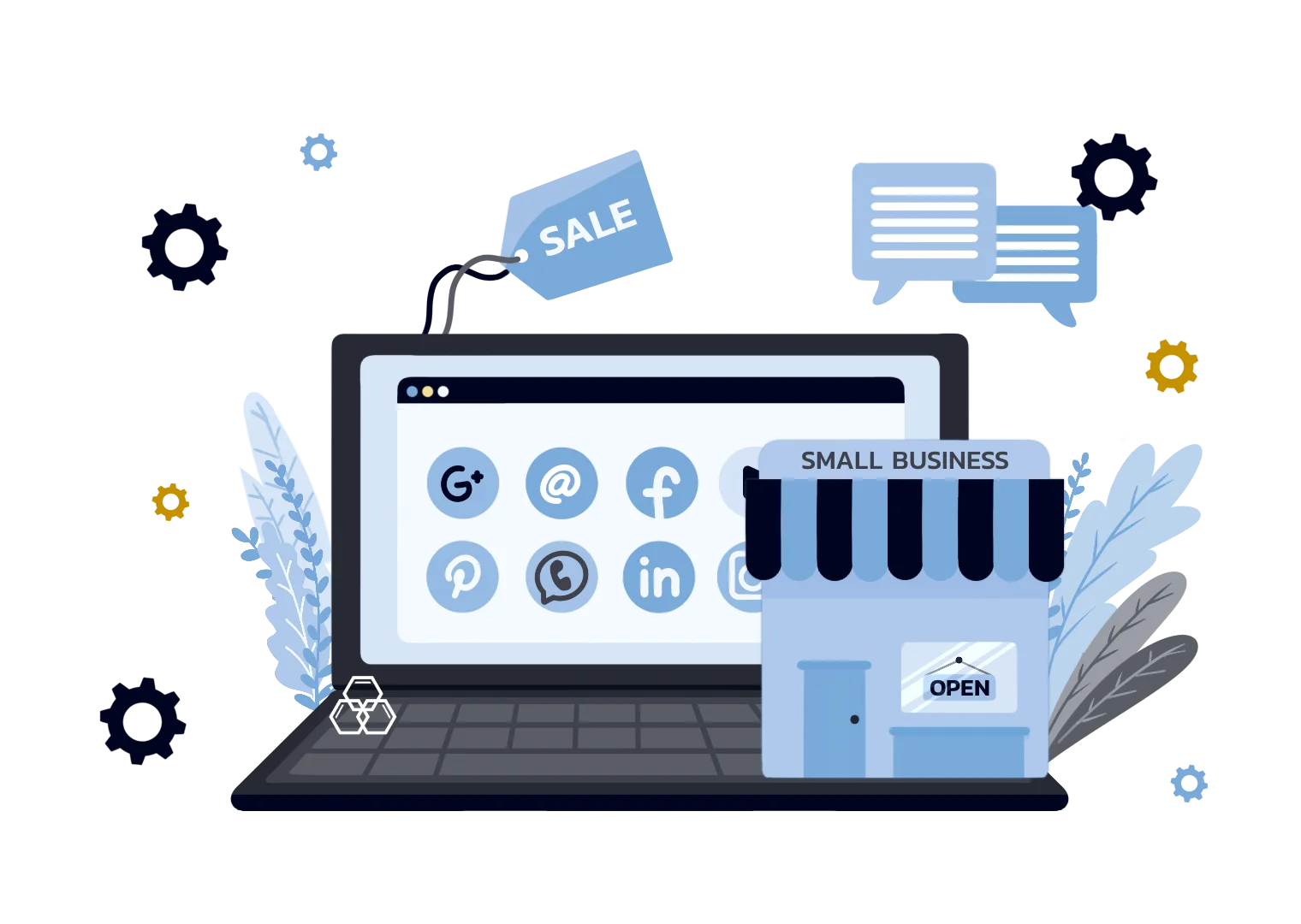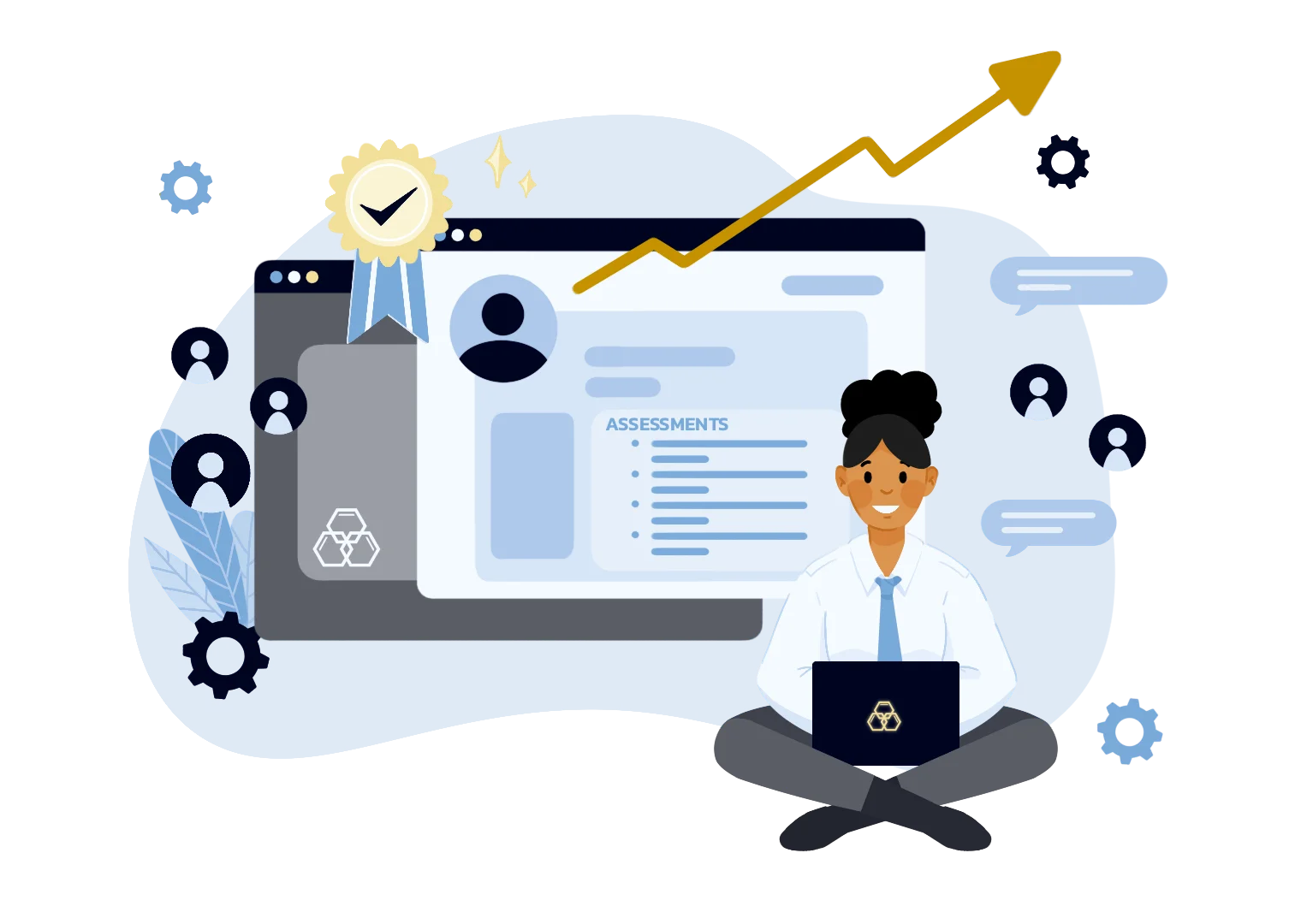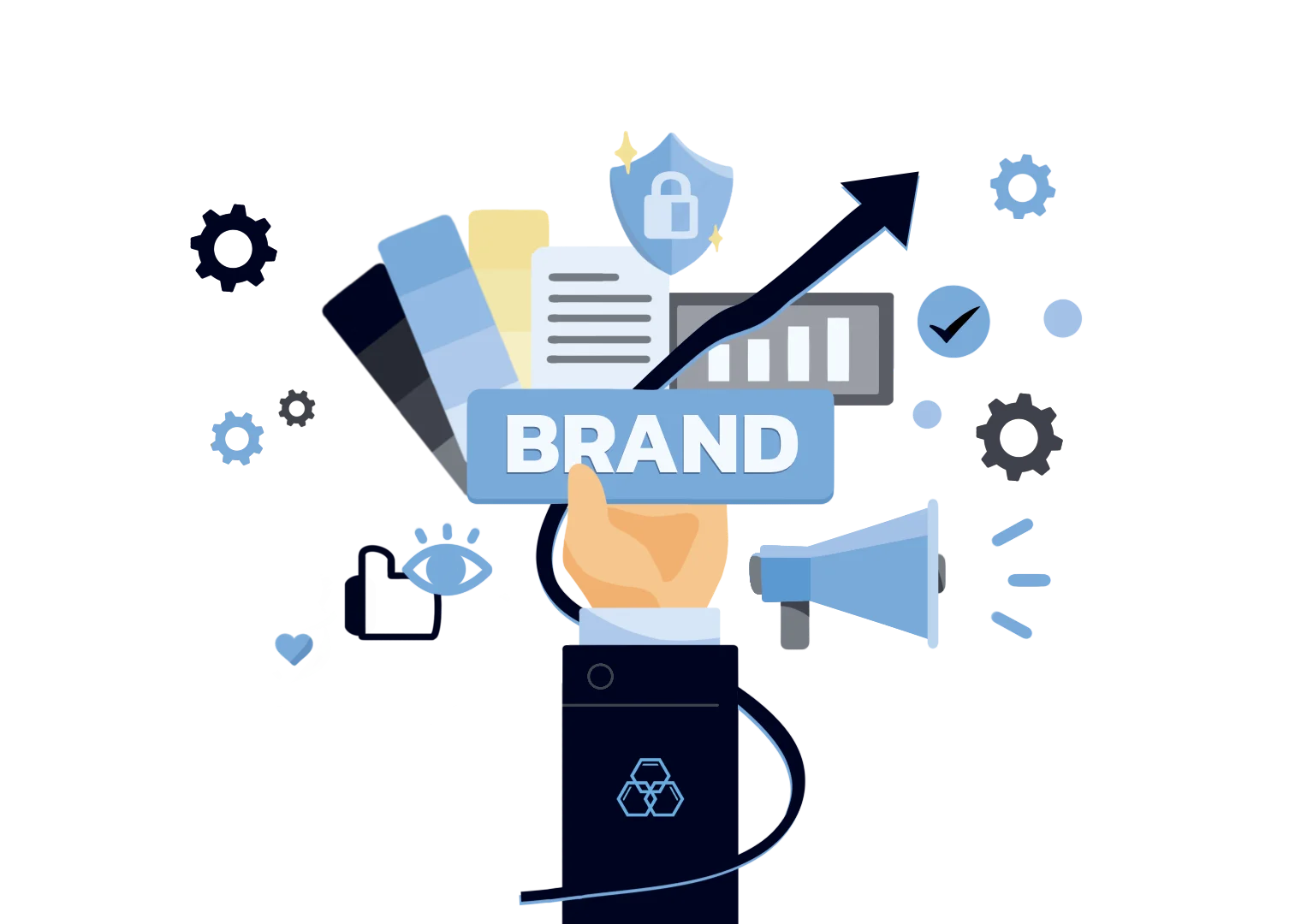From reaching new customers to building long-term brand loyalty, a strong online presence can level the playing field against larger competitors. Yet, for many small business owners, the digital marketing landscape can feel overwhelming.
Limited budgets, lack of time, and rapidly changing trends make it challenging to know where to start or how to stand out.
This guide is designed to change that. We’ll break down practical, cost-effective online marketing strategies that cut through the noise, helping you not only keep up but gain a real competitive edge.
Let’s get started!
What is Digital Marketing for Small Businesses?

Digital marketing helps small businesses promote products or services online and connect with customers. It includes social media campaigns, email newsletters, search engine optimization, and paid ads.
The goal is to reach customers where they spend their time, on their phones, tablets, and computers. Businesses use data to improve their marketing efforts.
Digital marketing reaches more people than traditional methods like print ads, billboards, or radio. It allows for better targeting and measurable results, often at a lower cost. For example, a newspaper ad usually reaches a limited local audience, while a good Facebook or Google ad can attract customers worldwide or target a specific market.
For small businesses, this means they can control their marketing budget, adjust ad campaigns quickly, and compete effectively with larger brands without spending too much.
Why is Digital Marketing Important for Small Businesses?

Wider Reach on a Smaller Budget
Unlike traditional advertising methods such as print, radio, or television, digital channels allow small businesses to reach vast audiences without a massive budget. With strategies like social media marketing, search engine optimization, and email campaigns, you can connect with potential customers across cities, countries, or even globally.
This means a local shop can promote its products to customers miles away without the high cost associated with physical marketing methods.
Precise Targeting
One of the biggest advantages of digital marketing is its ability to zero in on a few platforms for the exact audience you want to reach. Platforms like Facebook Ads and Google Ads let you filter your campaigns based on demographics (age, gender, location), interests, purchasing behaviors, and even life events.
Instead of casting a wide net and hoping for results, you focus your efforts on the people most likely to buy from you, saving both time and money.
Measurable Results

With traditional marketing, it’s hard to know exactly how many people saw your ad or how effective it was. Digital marketing changes that. Analytics tools provide real-time data on clicks, conversions, engagement, and sales.
This allows you to measure online advertising performance, identify what’s working, and quickly make adjustments to improve your ROI. Every decision can be backed by actual numbers rather than guesswork.
Level Playing Field
In the online world, your size doesn’t matter as much as your strategy. With a strong digital presence, even the smallest business can appear alongside established brands in search results, social feeds, and online marketplaces.
Well-crafted content, smart SEO, and targeted ads can help you stand out and compete directly with bigger players without matching their marketing budgets.
Stronger Customer Relationships

Digital marketing allows you to interact with your existing customers consistently and meaningfully. Whether it’s through engaging social media posts, helpful blog content, or personalized email campaigns, you can build trust and stay top-of-mind.
Over time, these ongoing touchpoints create loyal customers who are more likely to return, recommend your business, and become brand advocates.
7 Digital Marketing Strategies for Small Businesses

Here are some proven approaches that small businesses can use to make the most of their online presence:
1. Search Engine Optimization (SEO)
SEO is the process of improving your business website’s visibility in search engines like Google, Bing, or Yahoo. The goal is to appear on the first page for keywords to drive traffic from your prospective customers.
For small businesses, this often means optimizing for location-specific terms (“florist in Ann Arbor”) or niche products and services.
Effective SEO for small businesses starts with keyword research. Use tools such as Google Keyword Planner or Ahrefs to find search phrases with moderate competition and high intent.
Once you identify relevant keywords, place them strategically in your website’s meta titles, descriptions, headers, and content.
SEO for local marketing is particularly important for small businesses. Claim and optimize your Google Business Profile, keep your business name, address, and phone number consistent across all local listings, and encourage customer reviews. These steps help your business appear in Google’s Local Pack, which can significantly boost foot traffic and inquiries.
Some Tips:
- Audit your website regularly using tools like SEMrush or Screaming Frog to catch broken links, slow load times, and technical issues.
- Publish high-quality blog posts that answer customer questions and target long-tail keywords.
- Use schema markup to help search engines understand your content and improve click-through rates.
2. Social Media Marketing

It uses social media channels such as Facebook, Instagram, TikTok, LinkedIn, and X (Twitter) to increase brand awareness, engage customers, and drive sales. The strength of social media lies in its ability to combine organic and paid efforts while offering advanced audience targeting.
For small businesses, success often comes from identifying the platforms where their target audience is most active. A business-to-business (B2B) service provider may benefit from LinkedIn and YouTube, while a café might focus on Instagram and TikTok for visual appeal.
Social platforms provide analytics dashboards where you can track reach, engagement, and conversions. This data allows you to test different formats, from image posts and short videos to live streams, and optimize based on performance.
Paid advertising on social media is also highly effective for small businesses due to its precise targeting options. You can narrow campaigns by location, demographics, interests, and even behaviors such as recent purchases. This makes sure ad spend is focused only on users most likely to convert.
Some tips:
- Use scheduling tools like Buffer or Later to maintain consistent posting without overwhelming your schedule.
- Invest in high-quality visuals and captions that tell a story rather than simply promote a product.
- Monitor analytics weekly and adjust your content strategy based on which posts generate the highest engagement or conversions.
3. Content Marketing

It is the creation and distribution of relevant content that attracts, educates, and nurtures potential customers. Unlike direct advertising, it aims to solve problems and answer questions your audience has, which builds trust over time.
Content can take many forms, such as blog posts, videos, podcasts, infographics, or downloadable guides, and should be tailored to your audience’s preferences.
The effectiveness of content marketing lies in its ability to generate long-term website traffic and leads. For example, a plumbing company could publish a blog series on “How to Prevent Common Home Water Leaks." These resources attract readers searching for solutions and position the business as a trusted expert.
To maximize reach, repurpose content across multiple platforms. A single blog post can be transformed into a YouTube video, a LinkedIn article, and a series of Instagram posts. This increases visibility without the need to constantly produce new material from scratch.
Tips for Small Businesses:
- Maintain a content calendar to ensure consistent publishing and avoid last-minute scrambling.
- Use keyword research tools to guide topic selection for SEO benefits.
- Guest post valuable content on reputable websites to gain authority.
- Always include a clear call-to-action, such as signing up for a newsletter or booking a consultation.
4. Email Marketing
It is one of the most cost-effective digital strategies for small businesses. It involves sending targeted, personalized messages directly to customers’ inboxes to nurture relationships, share updates, and drive sales. Unlike social media, where algorithms control reach, email allows you to communicate with your audience without relying on third-party platforms.
A successful email marketing campaign starts with building a quality subscriber list. This can be done by offering incentives such as discounts, free resources, or exclusive updates in exchange for a customer’s email address.
Once you have a list, segment it based on customer behavior or demographics so that marketing messages are more relevant, for example, sending different promotions to first-time visitors versus repeat buyers.
Automation tools like Mailchimp, ConvertKit, or Brevo (Sendinblue) let you set up sequences that trigger based on actions, such as welcoming new subscribers or sending follow-up reminders after an abandoned cart. Small businesses can greatly benefit from automation, as it saves time while maintaining consistent customer engagement.
Tips for Small Businesses:
- Keep subject lines short, clear, and compelling to improve open rates.
- Use A/B testing to find out which email formats, visuals, and CTAs work best.
- Avoid sending too frequently; focus on delivering valuable, relevant content to maintain trust.
5. Pay-Per-Click (PPC) Advertising
It places your business at the top of search engine results or on high-traffic websites, and you only pay when someone clicks your ad. For small businesses, this means instant visibility without waiting months for SEO results. Platforms like Google Ads and Microsoft Ads are popular choices, but social media platforms such as Facebook and Instagram also offer PPC models.
To get the most from PPC, start with specific, targeted campaigns. Use keyword research to identify high-intent search terms relevant to your products or services. If you own a local repair shop, targeting “laptop repair near me” ensures you attract people actively looking for your service. Geo-targeting can further narrow your audience to only those within your service area.
The key to PPC success for small businesses is constant monitoring and optimization. Track click-through rates (CTR), cost per click (CPC), and conversion rates, then adjust bids, ad copy, and targeting to maximize ROI.
Tips for Small Businesses:
- Use ad extensions in Google Ads to display extra information like phone numbers or promotions.
- Set daily or monthly budgets to prevent overspending.
- Start small, test different ad variations, and scale the ones that perform best.
6. Local SEO and Listings Management

Local SEO focuses on optimizing your online presence so your business appears in search results for location-based queries. This is especially valuable for small businesses that serve a specific geographic area, such as restaurants, salons, or service providers.
The foundation of local SEO is your Google Business Profile. Fill in all details like:
- Business name
- Address
- Phone number
- Operating hours
- Services
- Photos
Leep them updated. Encourage satisfied customers to leave positive reviews, as these influence both your search rankings and customer trust.
Consistency is critical in listings management. Ensure your NAP (Name, Address, Phone) information is identical across directories like Yelp, Bing Places, TripAdvisor, and industry-specific listings. Inconsistent information can harm rankings and confuse potential customers.
Tips for Small Businesses:
- Add high-quality photos to your listings to improve click-through rates.
- Post regular updates or offers on your Google Business Profile to boost engagement.
- Use location-based keywords in your website content, meta descriptions, and headings.
7. Influencer and Partnership Marketing

Influencer marketing involves collaborating with individuals who have established credibility and a following in your target market. For small businesses, this doesn’t always mean expensive celebrity endorsements; micro-influencers (1,000–50,000 followers) often provide better engagement rates and are more affordable.
Partnership marketing takes a similar approach by teaming up with complementary businesses to cross-promote. For example, a local gym could partner with a health food café to offer joint promotions or share each other’s social media content.
Influencer and partnership marketing work well for small businesses because they tap into existing trust and communities. When a trusted figure recommends your product or service, their audience is more likely to try it.
Tips for Small Businesses:
- Choose influencers or partners whose audience closely matches your target market.
- Clearly outline deliverables, timelines, and compensation before starting collaborations.
- Track results using unique promo codes or custom landing pages to measure ROI.
Tips for an Effective Digital Marketing Campaign
Small business owners often approach digital marketing with enthusiasm, but without the right structure and insight, campaigns can quickly underperform. Here are some tips to prevent that:
1. Work with a Digital Marketing Agency to Fast-Track Results
While it’s possible to run campaigns yourself, a reputable digital marketing agency can accelerate success and reduce costly trial-and-error. Agencies bring specialized expertise in SEO, PPC, social media management, content marketing, and analytics.
They also have access to premium tools, keyword research platforms, competitor tracking software, and advanced analytics dashboards, which may be too expensive or complex for solo use.
An agency can:
- Audit your current strategy and identify gaps you might not see, such as under-optimized landing pages or wasted ad spend.
- Develop a custom strategy tailored to your audience, budget, and goals instead of relying on generic advice.
- Run data-driven campaigns using advanced tracking to monitor results in real time and adjust before problems snowball.
- Produce high-quality creatives that match the brand voice and appeal to your target market.
- Free up your time to focus on running your business, while they handle optimization and reporting.
For small businesses, this often means reaching profitability faster, avoiding expensive mistakes, and competing more effectively with larger brands that have in-house teams.
2. Avoid Spreading Yourself Too Thin
Trying to be active on every online channel at once often results in mediocre performance across the board. Focus on one to three platforms where your audience is most active, and master those before expanding. Concentrated effort allows you to refine messaging, test formats, and allocate budget more efficiently.
3. Don’t Ignore Your Data
Metrics like conversion rate, click-through rate, and cost per acquisition are critical for decision-making. If you’re not regularly reviewing your analytics, you risk continuing ineffective strategies that drain your budget. Use free tools like Google Analytics or platform-specific dashboards to guide optimizations.
4. Watch Out for Audience Fatigue
Even your most loyal audience will tune out if they see the same content repeatedly. Refresh ad creatives, update imagery, and test new formats like video or interactive polls to keep engagement high. Simple changes, such as seasonal variations or updated headlines, can make a big difference.
5. Don’t Chase Every Trend
Trends can generate quick engagement but may not align with your brand or target market. Jumping on irrelevant trends risks confusing your audience and diluting your brand identity. Adopt trends selectively, ensuring they fit your tone, values, and audience preferences.
6. Keep Your Budget Flexible
Digital marketing is dynamic, and a rigid budget can limit growth opportunities. Set aside a portion of your ad spend for testing new channels, audiences, or creative approaches. If a campaign outperforms expectations, be ready to reallocate funds to scale results quickly.
7. Never Sacrifice Quality for Quantity
Frequent posting helps maintain visibility, but quality should always come first. High-quality, relevant content strengthens credibility, boosts engagement, and supports long-term SEO, all crucial for small businesses competing with larger brands.
FAQs
1. What are the four types of digital marketing?
The core types are:
- Search Engine Optimization (SEO) – Improves your site’s visibility in search results to attract free, organic traffic.
- Pay-Per-Click (PPC) Advertising – Paid ads where you’re charged only when someone clicks, such as Google Ads or Facebook Ads.
- Content Marketing – Sharing content like blog posts, user-generated content, videos, or guides to attract and nurture leads.
- Social Media Marketing – Using platforms like Instagram, Facebook, LinkedIn, or TikTok to engage audiences and promote offers.
2. How to market your small business?
Identify your ideal customer, create a professional and mobile-friendly website, and optimize for local SEO so nearby buyers can find you. Use content marketing to provide value, run targeted ads for quick exposure, and maintain an active presence on the platforms where your audience spends time. Don’t forget to follow up through email marketing and customer reviews.
3. Can a beginner do digital marketing?
Yes. Many tools are designed for non-experts, and free training is widely available. Beginners should start small with simple platforms like Facebook Ads Manager or Google Business Profile, test campaigns with modest budgets, and learn from analytics. Over time, you can layer in more advanced tactics or work with an agency to scale faster.
4. What is the best app to advertise your business?
It depends on your audience and goals:
- Facebook & Instagram Ads – Highly targeted and visually driven, great for most small businesses.
- Google Ads – Reaches people actively searching for your product or service.
- TikTok Ads – Best for creative, short-form content targeting younger audiences.
- LinkedIn Ads – Ideal for B2B and professional services.
5. Which digital marketing strategy is best for beginners?
Combining video content with social media marketing is a strong starting point. Video brings eyes, while social media gets it in front of the right people. Pair this with local SEO for visibility in your area. Once you have steady engagement, test PPC for faster lead generation.
Final Thoughts
Understanding the fundamentals of a small business marketing plan and applying targeted strategies, you can compete with larger players, reach more customers, and grow sustainably without wasting resources.
Let us know how Evolv can help your digital marketing efforts!
Also, check out our blog and be updated with the latest marketing insights.







